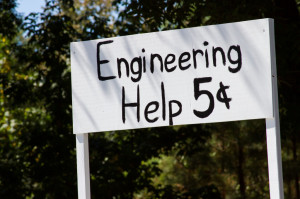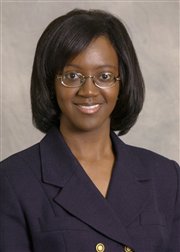Making the flip: Sirena Hargrove-Leak sees sparks in student engagement
 Sirena Hargrove-Leak, assistant professor of engineering, is implementing flipped instruction in her Engineering Mechanics-Statics course. The course is one of the first that challenges second-year students to solve complex problems in engineering. The problem-solving aspect is the main reason Hargrove-Leak chose to flip the course.
Sirena Hargrove-Leak, assistant professor of engineering, is implementing flipped instruction in her Engineering Mechanics-Statics course. The course is one of the first that challenges second-year students to solve complex problems in engineering. The problem-solving aspect is the main reason Hargrove-Leak chose to flip the course.
“I have, through experience, determined that the best way to learn to solve problems is to solve problems,” Hargrove-Leak says. “Therefore, by flipping the course, I’m able to allow the students more time to practice solving problems, and it gives me a chance to be there when they are struggling to solve problems so it gives me a better view into the places where they get stuck.”
Instead of lecturing students, Hargrove-Leak says she can provide support where students need it most with flipped instruction.
How do you flip?
Hargrove-Leak started off the semester by opening up to her students, telling them what flipped instruction was and why she thought it would benefit them. She would assign textbook chapters and offer publisher-provided PowerPoints to students outside of class. In class, the students would take a brief low-stakes quiz to start and then spend most of class time working in teams to solve problems on custom whiteboards.
For the most part, her students hopped on board.

Dr. Sirena Hargrove-Leak, assistant professor of engineering at Elon University, has implemented flipped instruction to give students more time for problem solving in class.
“They hop up, they grab the boards and they engage in problem solving,” Hargrove-Leak says. “It’s the most beautiful thing ever. It has really re-enlivened my teaching. I just feel like I’m so much more effective.”
According to Hargrove-Leak, one of the greatest benefits of flipped instruction is that it gives students a chance to teach other students. She says peer instruction reinforces learning for both the student explaining the concept and for the student having the information explained to him or her.
“Through experience, I have learned to appreciate that I am not the only teacher in the classroom,” she says. “As instructors, we explain things the way that we understand them, but that doesn’t mean that everyone understands it that way, so if a peer gets it and is able to explain it in a different way, that is such a benefit to both students.”
Hargrove-Leak uses Pearson’s MasteringEngineering program to supply students with supplementary materials to help ensure students are prepared for class. From video solutions to tutorials to personalized problem sets that differ from student to student, the elements of the online textbook have helped Hargrove-Leak gauge where students are struggling and what types of problems to focus on during class time.
She flipped and you can too
Utilizing publisher-provided materials is just one way Hargrove-Leak suggests working to apply flipped instruction. She says it’s not worth reinventing the wheel if the resources students need are readily available.
Hargrove-Leak says faculty should also consider another important resource available to them: the knowledge base and experience of colleagues. She says the office of Teaching and Learning Technologies has made it easier for her to take audio and photo notes on solving problems with a LiveScribe SmartPen. This technology has helped her fulfill her flipped learning goals.
Overall, Hargrove-Leak says that having an open mind, being forthright with students about reasons for flipping and allowing time to flip a course are the best things an interested instructor can do. Because there are so many ways to flip a course, anyone in any discipline can do it, and Hargrove-Leak says flipping will make a difference.
“There’s nothing worse than standing there at the white board explaining your heart away, and you look out at the class and they’re just looking at you with blank stares,” she says. “They don’t respond when you ask them questions.
“By flipping, the students come to class and they’re hungry for it. They come in to class, they grab their white boards and they’re ready to go, and that’s just been the best thing.”
Engineering image from Flickr user SamWhited | Creative Commons BY
 Follow
Follow
